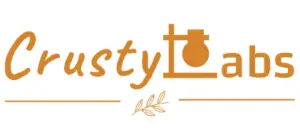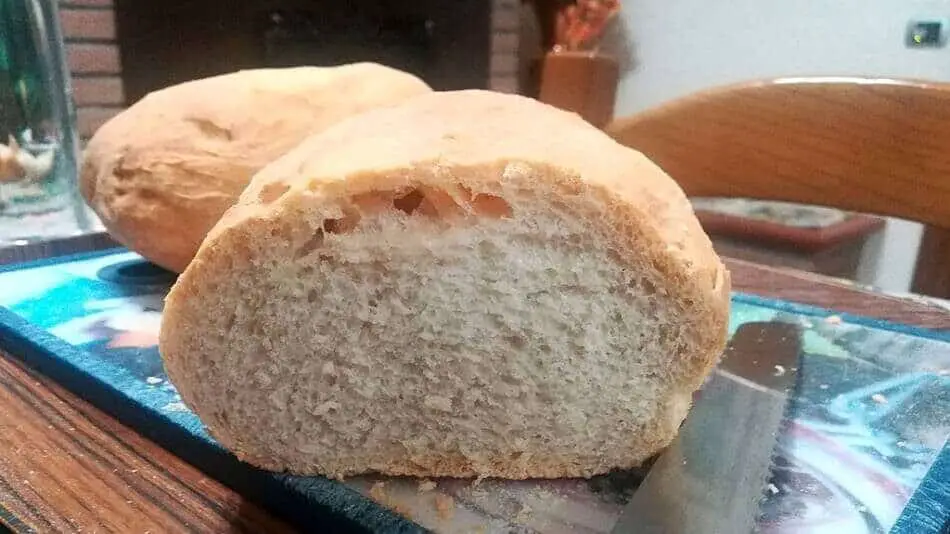The Pane di Casa is a traditional Italian bread that translates to ‘bread of the home’; it is typically baked using commercial yeast and sometimes includes a high proportion of semolina flour.
The main difference between sourdough bread and Pane di casa is that sourdough bread is leavened through the use of a natural pre-ferment containing wild yeast and bacteria, while the Pane di Casa is leavened through the use of commercial yeast like dry yeast, instant yeast and fresh yeast.

Leavening Agent: Wild Yeast and Bacteria vs Commercial Yeast
Sourdough breads are leavened using a natural pre-ferment or a sourdough starter where a mixture of flour and water has been allowed to mature over time, to build a strong living culture of fermentative wild yeast and bacteria. The fermentation gasses released by these naturally present microbial organisms gets trapped in the dough and causes the dough to rise.
Pane di Casa breads on the other hand are leavened using commercial yeast in the form of dry, instant or fresh yeast. Similar to the wild yeast and bacteria, the commercial yeast strain ferments the dough and releases carbon dioxide gasses which rises the bread.
The type of leavening agent used in both breads behaves differently in the dough, which renders differences in the way the two breads are baked, and how they taste and look.

Ingredients: Flour type and oil
Sourdough bread is typically made with wheat, rye or spelt flour, and only some recipes calls for the inclusion of oil to provide a richer taste to the baked bread.
Pane di Casa on the other hand, is often made with equal proportions of wheat and semolina flour, and oil is always included in the bread.
Baking Process: Straight dough mixing, Fermentation time and Shaping
Straight dough vs Pre-ferments
Sourdough breads are made using a pre-ferment, where a small portion of the flour in the final dough has been allowed to ferment for many hours before the rest of the flour in the dough is mixed in. The flour that has been left to ferment before it is mixed into the rest of the dough is called the pre-ferment, sourdough starter or the levain.
There are two steps before a sourdough enters bulk fermentation:
- preparing the pre-ferment
- mixing the pre-ferment and dough together
Pane di Casa bread on the other hand is made using a straight dough technique where all flour in the dough starts and ends fermentation at the same time.
There is only one step before the Pane di Casa dough enters bulk fermentation, which is the mixing of all ingredients including the yeast and all the flour; no pre-ferment is used in the baking of Pane di Casa bread.
Fermentation time
Bulk fermentation and final proofing time is shorter for the Pane di Casa bread as commercial yeast has a much faster fermentation rate when compared to the fermentation rate of wild yeast and bacteria in a sourdough bread.
Bulk fermentation time and final proofing time is 30mins to 1hour less each, when baking the Pane di Casa bread. Since the fermentation rate of commercial yeast is a lot higher, we should be careful not to ferment the dough for too long, which will overproof it, leading to large uneven holes in the crumb of the bread.
Shaping
Sourdough bread can be found in many shapes and sizes, from the round boule, the oval batard, to the long and thin baguette. Pane di Casa on the otherhand, is typically baked into an oval shape or a long and thin shape like a baguette.
Flavor and Texture: Sour vs Yeasty
Flavor
The commercial yeast used in Pane di Casa bread making imparts a strong yeasty taste to the bread while sourdough bread leavened with wild yeast and bacteria has a more complex sourness.
The fermentative bacteria in sourdough bread releases organic acids into the dough, which imparts a complex flavor profile and sourness to the bread. Pane di Casa breads on the other hand, does not have a strong population of these acid producing bacteria but has a strong population of commercial yeast which imparts a yeasty flavor to the bread.
The semolina flour commonly used in the Pane di Casa breads imparts a sweet taste to the palette, while the oil in the bread imparts a richness to the crumb.
Texture
The Pane Di Casa bread is traditionally made to have a dense and chewy crumb with a crunchy crust. Semolina flour used in the Pane di Casa bread has a very high gluten content, which causes the crumb to be chewy and the crust to be crunchy. The long and thinly shaped dough also reduces baking time in the oven, which helps to keep the crust thin and crispy.
Sourdough breads is baked to produce a variety of texture, to suit the baker’s needs; the density of the crumb, the sizes of the holes in the crumb and the crunchiness and thickness of the crust varies greatly.


